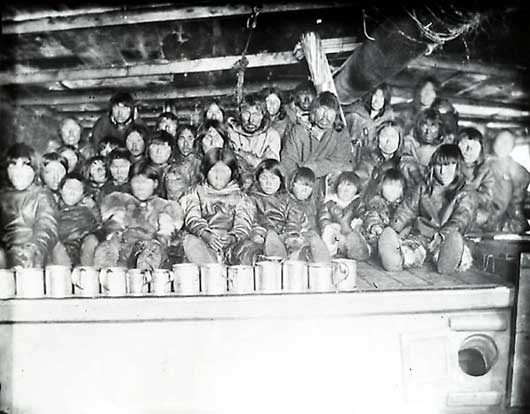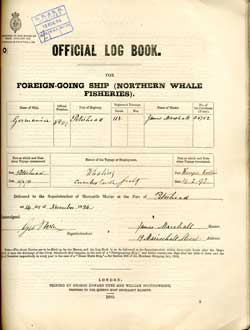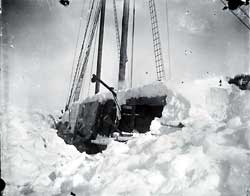Whale " Men "
Inuit Whalers of Cumberland Sound
Before the arrival of European whaling vessels, Niatitick was the most southerly settlement of the Talirpingmuit, the Inuit people of the west side of Cumberland Gulf. They came each fall to hunt seals in the surrounding fjords and channels. In winter, they would move to Blacklead Island where they hunted bears in the spring, and then went on their annual inland caribou hunt and returned to Niatitick again in the fall. Because of its harbor and its Inuit people, Blacklead Island became a popular overwintering site for Scottish whaling vessels.
When, in 1860, Captain William Penny of Peterhead froze his two ships into the ice at Cumberland Sound he broke with the traditional calendar organization of whaling expeditions from the ports of Scotland, northern England and northern Europe (Sanger, 184). He was banking on access to the bone and oil from whales taken in the early Spring in the Cumberland Gulf fishery, but for this he was in need of indigenous people’s labour. Whaling masters were already well acquainted with the Inuit, whom they called “natives”, or otherwise knew as Eskimos. They regarded them as less troublesome than European or US crews, and while they also respected their proficiency with new technology, what counted most was the cheapness of their labour. This mattered as the declining demand for whale products and the decrease of the stock pushed whaling into marginal profitability.


Captain Penny pioneered the over-wintering voyage that lasted approximately fourteen or fifteen months. These voyages consisted of the outward voyage, fall whaling, over-wintering, the spring fishery and the homeward journey. The crews of the vessels signed a special Northern Whale Fishery Agreement for the long-term, but in effect their jobs were confined to transport, since it was Inuit whalers, engaged on a very different basis and without formal agreement, who prosecuted the fishery. Inuit manned the small whaling boats that delivered catches to masters of the vessels who then ferried the products back to Europe and the US. They were remunerated with clothes, rifles, tea, and tobacco that were brought out in the transport vessels. When a bargain was made with an Inuit whaler, it was understood this extended to the whole of the family.
Germania was a Scottish whaler that set out for the Davis Straits in June 1891 (Official No. 89101, 1891, MHA). According to the master's log, on September 28, the vessel "left Niatitick with all my whaling crew of natives, their wives and families number in all of them 52 told and eight of European crew" (Official Log, September 28, MHA). All might have been well on the Germania until she ran aground and by the end of October was stuck in the winter ice on Baffin Island. Events thereafter are recounted in a lengthy official log. The whaler was holed up while most of the European crew left and were repatriated through St. John's. The Master and the cabin boy stayed behind, but they were not alone. The vessel would have sunk but for the heroic effort at pumping her out by five Inuit (Official Log, February 15, MHA).
 The five Inuit who pumped the Scottish whaling vessel took turns around the clock to keep her afloat, preserving a piece of capital equipment which was barely worth its name "My natives cannot stay longer with me they must go deer hunting but will return about October," the master wrote. "The ship must lay here until they come back," he continued, "there is five women to pump ship morning and evening" (Official Log, August 15, MHA). Revealed at the end of the master’s account is the fact that the natives "manning" the pumps were women.
The five Inuit who pumped the Scottish whaling vessel took turns around the clock to keep her afloat, preserving a piece of capital equipment which was barely worth its name "My natives cannot stay longer with me they must go deer hunting but will return about October," the master wrote. "The ship must lay here until they come back," he continued, "there is five women to pump ship morning and evening" (Official Log, August 15, MHA). Revealed at the end of the master’s account is the fact that the natives "manning" the pumps were women.

